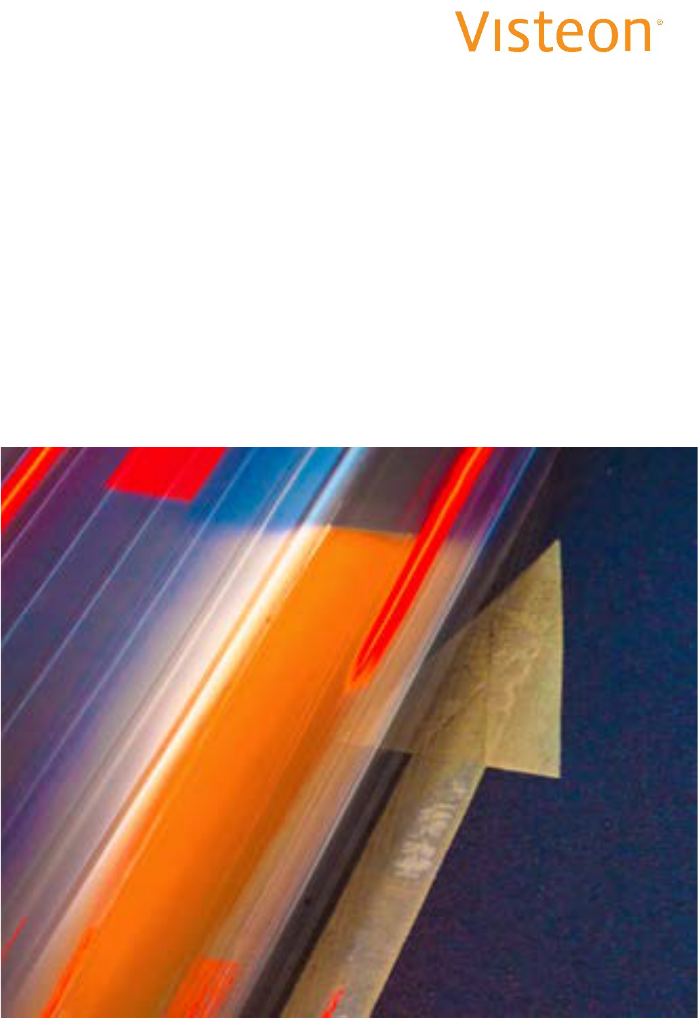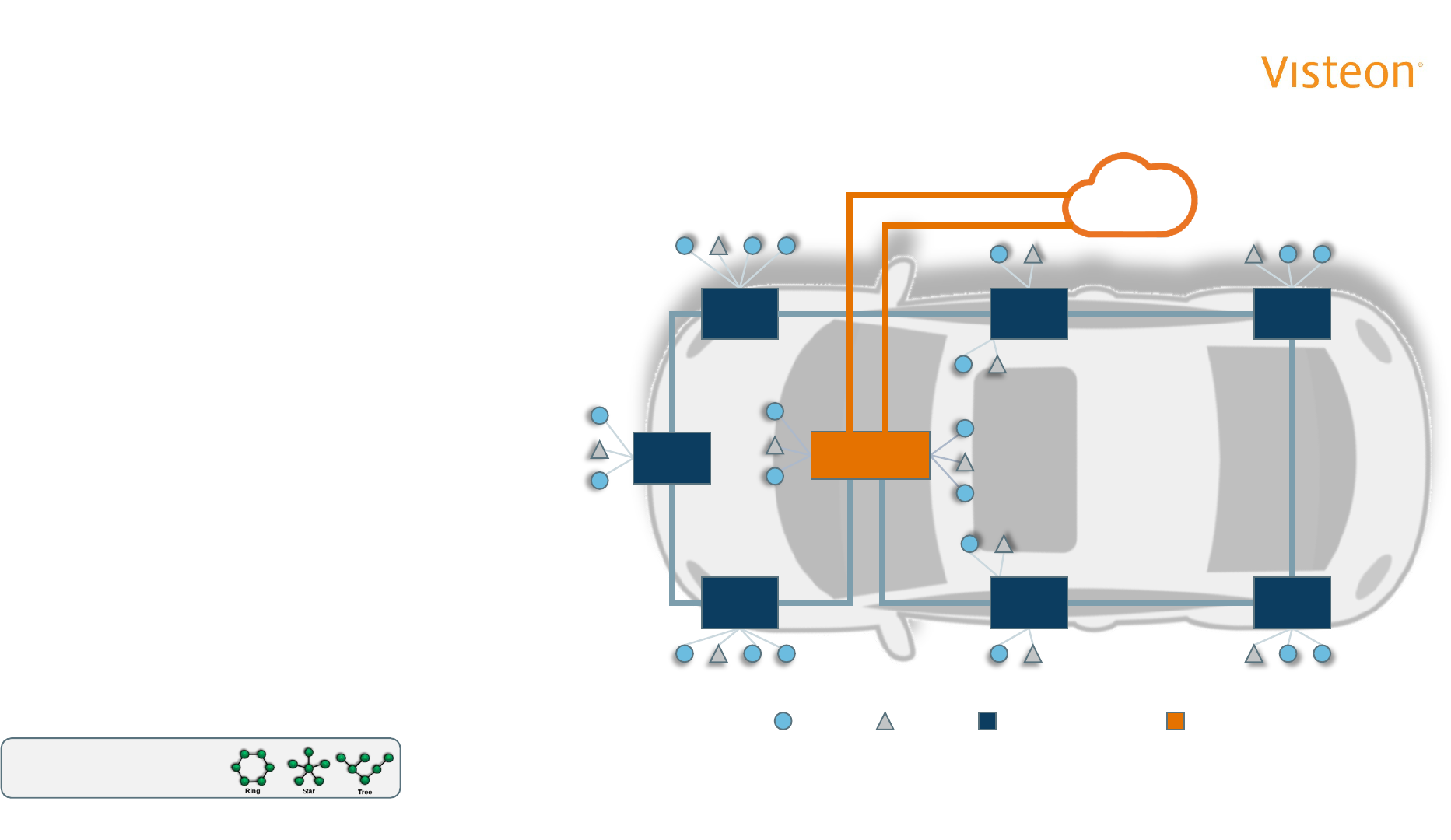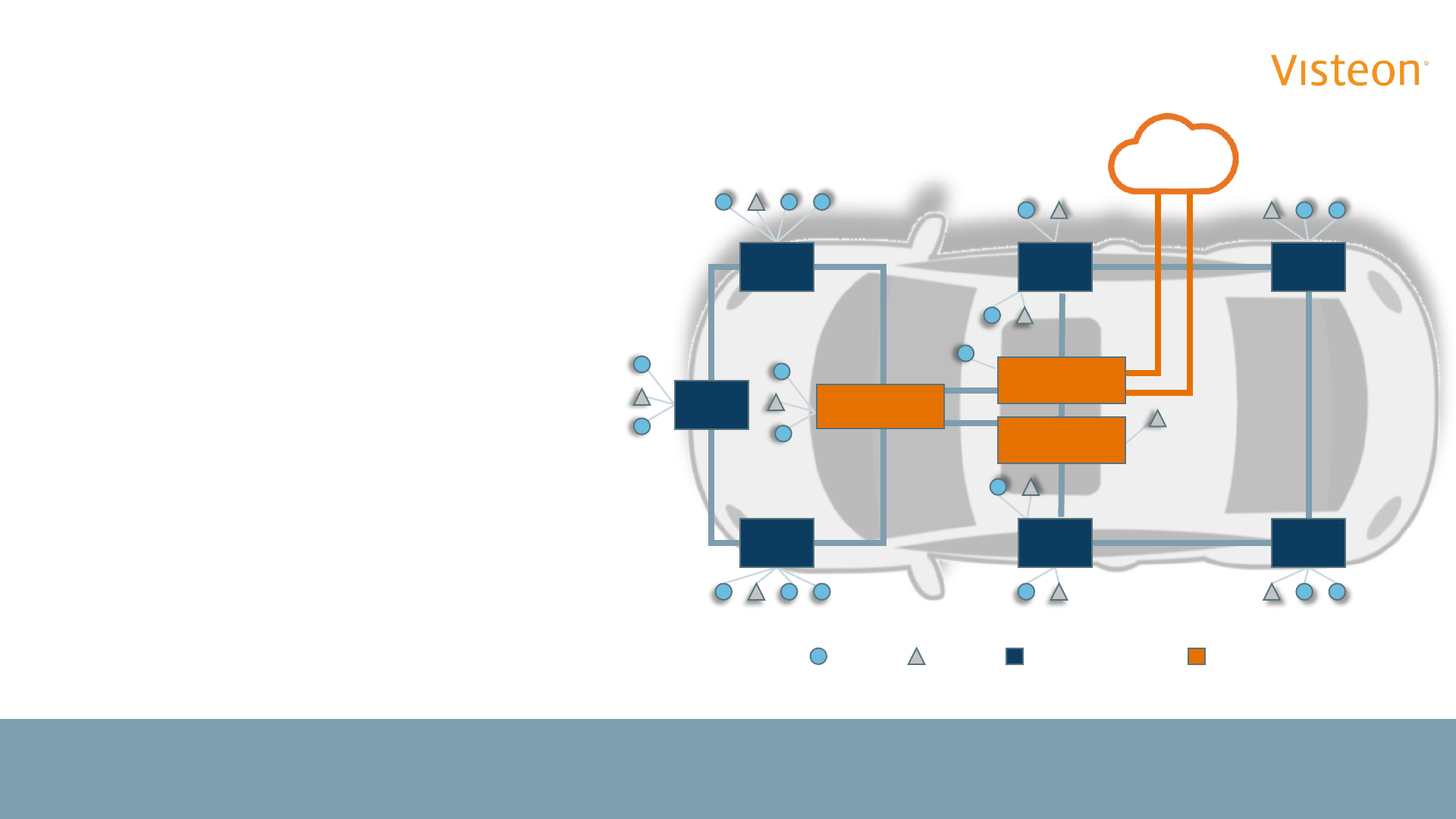
Zonal EE Architecture:
Towards a Fully Automotive Ethernet–Based Vehicle
Infrastructure
Jochen Klaus-Wagenbrenner
September 24, 2019

Agenda
2
• Company Background
• Automotive Cockpit & ADAS/AD Technology Trends
• Motivation and Impacts for a New EE Architecture
• Zonal EE Architecture
• Architecture Development
• Power Distribution
• Zonal Gateways and Super Cores
• Example for Topology Optimization
• Service-Oriented Architecture
• Challenges
• Summary

Visteon Product Portfolio
Comprehensive Cockpit Electronics Portfolio
Source: Rankings from 2016 ABI Research and IHS Markit.
Instrument
clusters
Head-up
displays
Infotainment Displays Self-drivingConnectivityCockpit
computer
Visteon Market Position
Top 5
Connected car
Tier 1 supplier
#1
Rank
Digital clusters
Head-up displays
#2
Rank
Center stack displays
3 Copyright © Visteon Corporation, 2019

Automotive Cockpit & ADAS/AD Technology Trends
4
ECU
Consolidation
Connected
Car
Cockpit for
Autonomous
Digital
Cockpit
New
EE
Architecture
MACRO TRENDS AUTOMOTIVE
COCKPIT AND ADAS TRENDS
Autonomous
Connected
Electric
Shared
L2+/L3
Highway
L3/
Experimental L4
L4
Motorways
L4/L5
2024 2027
2030
2021
Copyright © Visteon Corporation, 2019

ECU Consolidation Roadmap
Central Computing for Optimized Cost, Weight, Power Distribution, Security, Flexibility
5
Reduces cost, weight and power
consumption
ECUs in a car
30 - 100+
Consolidation of ECUs into
domain controllers
Leverages silicon and software
innovations
Parallel computing carrier offer
redundancy and safety
Service-Oriented Architecture
(SOA) direct memory access
Open scalable platform for OEM
system integration
Domain ECUs
Modular
Redundant Computing Platform
Yesterday Today Tomorrow Future
Dynamic configuration and
seamless redundancy
Service-Oriented Architecture (SOA)
network access oriented
Blade upgradeable concept
Central Computing Platform
Compute 1
Compute 2 Compute 1
Copyright © Visteon Corporation, 2019

Motivation for a New EE Architecture
Copyright © Visteon Corporation, 2019 6
EE Architecture Is About to Change
• Current EE architectures with domain controllers and a central gateway have
grown over time and became very complex:
• 3
rd
heaviest part up to 80 kg
• Absolute length of up to 5 km
• 3
rd
highest cost component, with a high cost of
labor (1000+ production minutes)
• Todays trends such as automated driving
increase significantly the demand for the
wiring harness:
• Increasing number of actuators and sensors
• Increasing data processing capabilities and
required data bandwidth in the vehicle
• Increasing need of intelligent power distribution

Impacts on EE Architecture
Copyright © Visteon Corporation, 2019 7
Automotive Ethernet TSN Transforms Future EE Architectures
• System architecture:
• Car wiring harness
• Organization and design of ECUs
• Peripheral devices: actuators and sensors
• Cloud connection
• Software architecture:
• Application and services
• Middleware and OS/BSP (Adaptive AUTOSAR)
• Game changers:
• Time Sensitive Networking (TSN)*
• Conversion into pure IP-based end2end real-time communication network
• Intelligent power distribution will be aligned with data distribution in the new
EE architecture at the same time
System Architecture Software Architecture
TSN*
impacts enables

Vehicle Zonal EE Architecture Tomorrow
8
• Zonal approach including first level
of consolidation in three domains:
• ADAS Super Core
• Body Super Core
• Cockpit Super Core
• Automotive Ethernet TSN
backbone with high bandwidth
and deterministic real-time
communication facilities
• Sensors and actuators are
connected to zonal gateway ECUs
Communication backbone
Copyright © Visteon Corporation, 2019
Sensor Actuator Zonal Gateway ECU Processing ECU
Automotive
Ethernet TSN
Front left
Middle
left
Rear left
Front
right
Middle
right
Rear
right
Super Core 2
Super Core 1
Front
Super Core 3

Vehicle Zonal EE Architecture Future
8
• Further consolidation of the
processing units
• Processing blades provide scalable
computational power
• Automotive Ethernet TSN
backbone architecture reused
• Zonal architecture blends upcoming
vehicle functions and technologies
with savings in weight and cost
Communication backbone
Copyright © Visteon Corporation, 2019
Sensor Actuator Zonal Gateway ECU Processing ECU
Automotive
Ethernet TSN
Front left
Middle
left
Rear left
Front
right
Middle
right
Rear
right
Front
Super Core

Vehicle Zonal Intelligent Power Distribution
8
• Dual battery scenario with
hierarchical power distribution
• Promoting the application of
electronic switches and fuses
• Integration in zonal gateways
allow for novel applications:
• Virtualizing the central fuse box
• Tailored fuse characteristics
• Intelligent power management:
load optimization and power saving
• Advanced fault prediction based on
current and voltage sensing
• Additional savings due to fuse
and load optimization
Copyright © Visteon Corporation, 2019
Automotive
Ethernet TSN
Front left
Middle
left
Rear left
Front
right
Front
Middle
right
Sensor Actuator Zonal Gateway ECU Processing ECU
Power distribution
Battery
Battery
Super Core
Rear
right

Vehicle Zonal EE Architecture
11
Zonal
Gateway
I2C, I3C, CSI, DSI, I2S
Automotive
Ethernet
10BaseT1s
100BaseT1
1000BaseT1
Multi GiG
LIN, CAN, PSI5, UART, SPI
PCIe, GMSLx,
FPDLx
Automotive
Ethernet
Multi GiG
Automotive Ethernet /
Wireless
Fast Ethernet (OBD)
Multi GiG
Super Core
eSwitches, eFuses
Zonal Gateway ECU
• Provides and distributes data & power and supports
any feature available in this specific vehicle zone
• Zone is a local vehicle specific portion of the vehicle
• Supports any kind of interface for sensors,
actuators, displays (network difference or signals)
• 10BaseT1s could replace other interfaces like CAN
FD, FlexRay, etc.
• Act as gateway, switch and as smart junction box
Super Core - Central Computing Platform
• Acts as inCar application server supporting
Service-Oriented Architecture (SOA)
• Multi SoCs-based control unit with Multi GiG
interface
• Specific SoCs (e.g. for AI)
• Fully scalable and upgradable platform
• Connects to Edge and Cloud back-end
• May act also as zonal gateway
Copyright © Visteon Corporation, 2019

Zonal Gateway ECU Design Approach
• Provide functionality for the vehicle zone
• Switch for IP devices and backbone
• Gateway for legacy devices (LIN, CAN, ...)
• Power delivery (PoDL, power cables)
• eSwitch/eFuse functionality
• Additional computation power capability
• Scalable
• MCU and application cores
• eFuse/high side power distribution
• Switch and gateway port count
• ASIL levels
• Mechanics
• Sealed and not sealed according build-in position
• Small footprint
• Moderate power dissipation
• High power distribution capability
PoDL - Power over Data Line
Ethernet
Switch
Main MCU
App
Core
Complex
RT Core
Complex
1000BT1
Redundant
Power
supply
Power
supply
1000BT1
Power
1000BT1
CAN
CAN
CAN
CAN
CAN
CAN
LIN
LIN
100BT1
100BT1
10BT1s
Backbone
Interface
eSwitch
/eFuse
Dev1
Dev2
Dev3
Dev4
Dev N
PoDL
PoDL
12
Copyright © Visteon Corporation, 2019

Case Study Setup – Optimized EE Architecture
13
• Estimate the wiring harness of different zonal architectures
• Qualify the trade-off between savings in harness and expenses on zonal ECUs
• Therefore an environment was set up to
• map the ECUs on the layout of the vehicle
• automatically generate a wiring harness from the positions of the ECUs
• analyze the harness and derive requirements for the design of the zonal ECU
• apply constrained 2D routing algorithms, considering single wire, etc.
Spatial mapping of the ECUs onto the layout of the vehicle
Wiring the ECUs in a zonal architecture and estimating the harness length
Copyright © Visteon Corporation, 2019

Case Study Result – Optimized EE Architecture
Copyright © Visteon Corporation, 2019
14
Zonal EE Architecture Leads to Significant Savings
• Zonal architectures bear savings of 50% and more in
length of the wiring harness for
• Control and distribute data
• Power distribution
• Increase of savings with larger number of
sensors/actuators
• Saving in wiring harness vs expenses on zonal gateway
ECUs: trade-off can be solved with 6 to 11 zones
• Complexity of the sub-harnesses drops down to a level
that allows automated manufacturing (max. wiring
connection length < 3 m, excluding the backbone)
• Uniformed zonal ECUs in numbers and types of
interfaces are potentially deployable across
• Variants and trim levels
• Platforms and car lines
Sensor Actuator Zonal Gateway ECU Processing ECU
Automotive
Ethernet TSN
Front left
Middle
left
Rear left
Front
right
Middle
right
Rear right
Super Core 2
Super Core 1
Front
Super Core 3
Sensor Actuator Zonal Gateway ECU Processing ECU

Service-Oriented-Architecture in Zonal Settings
15
• Disruption in EE topology impacts the software ecosystem
• Functions no longer associated by ECU, but by domain
• A single function is constituted by services, provided by
different ECUs
• Several SW suppliers delivering services to the same ECU
• Business logic of functions moved to a central application server
• Standards supporting SOA
• Adaptive AUTOSAR
• ARA::COM communication middleware
• Common API is a base for SOA
• Communication between domains via SOME/IP
• Key benefits
• Allows portability of functions on different ECUs / domains
• Enabler for realizing onboard / offboard function split
• Increases potential for reusability of Software Components (SWC)
Function
ECU 1 ECU 2
ECU 3
S1
S2 S3
Functions are broken down into services,
Services run on different ECUs,
ECUs are interconnected via Automotive Ethernet TSN.
Copyright © Visteon Corporation, 2019

Applying the Advantages of SOA
Copyright © Visteon Corporation, 2019
16
Combination of Zonal Architecture and SOA Proliferate Functionalities
• Abstract from physical to logical connections
• Services availability throughout the
IP-based network
• Well-established experience from
other industries are applicable
• Legacy communication mechanisms
will remain
• Mission critical ECUs (e.g. ESP)
using signal-based communication
• Services can be mapped on legacy
ECUs, e.g. using Classic AUTOSAR
• Novel functions without changes
on ECUs and on wiring harness
• Decreased topology complexity
• Increased potential of wiring optimizations
Automotive
Ethernet TSN
Front left
Middle
left
Rear left
Front
right
Middle
right
Rear
right
Front
S1
S2
S3
Sensor Actuator Zonal Gateway ECU Processing ECU
Service/ Function
Super Core
F
Sensor Actuator Zonal Gateway ECU Processing ECU Service/Function

Overall Challenges of Zonal EE Architectures
17
• Conspicuous product and system requirements
• Safety requirements, e.g. missing solutions in standards
• EMC induced by combination of data and power distribution
• Additional space requirements for installation in the vehicle
• Heat dissipation on high performance computing units or power switching
• Early start-up scenarios
• Implications on the system architecture
• Partitioning of data processing: smart sensor vs cloud processing
• Integration of high data rate sensor / actuator, such as raw data cameras, e.g. > 1Gbit/s
• Integration of very low complexity and legacy device, e.g. “cheap” ECUs (LIN, CAN)
• Interplay between multiple real-time communication channels, legacy traffic, class traffic, etc.
• Structural implications
• Optimization of various cost trade-offs, such as production – material – labor
• Organizational barriers between communication network vs power distribution departments on OEM and
supplier side
• Collaboration model in development and production in between OEM, Tier 1s and Tier 2s
• Availability of cutting edge ECU components, e.g., TSN enabled switches, eFuses, etc.
• Global deployment of uniformed zonal gateways at OEM production sites in dedicated car lines / trim levels
Copyright © Visteon Corporation, 2019

Partitioning of Data Processing in the Zonal Setting
18
• The data processing shall happen in
real-time with low latency
• Sensors create data which can be
processed either
• next to the sensor (smart sensor),
• in a zonal ECU with appropriate
computational power,
• in a central compute node such as
Super Core or
• off-board in Edge or Cloud computing
facilities.
• Data processing is attributed by the
• data rate at the input/output side,
• computational power required to process
the data
• Fusion of data can be done with
• raw sensor data (early fusion) or with
• processed data: object data (late fusion)
• Central fusion of raw data may make
sense for novel “AI” techniques but
requires significant bandwidth
Super Core
Zonal ECU
Sensor Actuator Zonal Gateway ECU Processing ECU
Sensor Actuator Zonal Gateway ECU Processing ECU
Copyright © Visteon Corporation, 2019

Summary - New Zonal EE Architecture
Copyright © Visteon Corporation, 2019 19
Zonal EE Architecture Unleashes Significant Savings
• Automotive Ethernet TSN network approach is
the common rail for the zonal architecture
• 1 to n zones
• High bandwidth and real-time communication
• Reliability and fail operational
• Zonal ring approach with is fully scalable:
• Entry to luxury segment
• Automated driving Level 1 to Level 5 (SAE)
• Combustion engine cars, EV’s and hybrid vehicles
• The zonal gateways will provide and distribute
data & power across the vehicle
• Zonal ECU concept matches the demands
of service-oriented architectures
• New developments in EE lead to a paradigm
shift, requiring bold re-organization of the
vehicle topology
Sensor Actuator Zonal Gateway ECU Processing ECU
Automotive
Ethernet TSN
Front left
Middle
left
Rear left
Front
right
Middle
right
Rear
right
Super Core 2
Super Core 1
Front
Super Core 3
Sensor Actuator Zonal Gateway ECU Processing ECU

